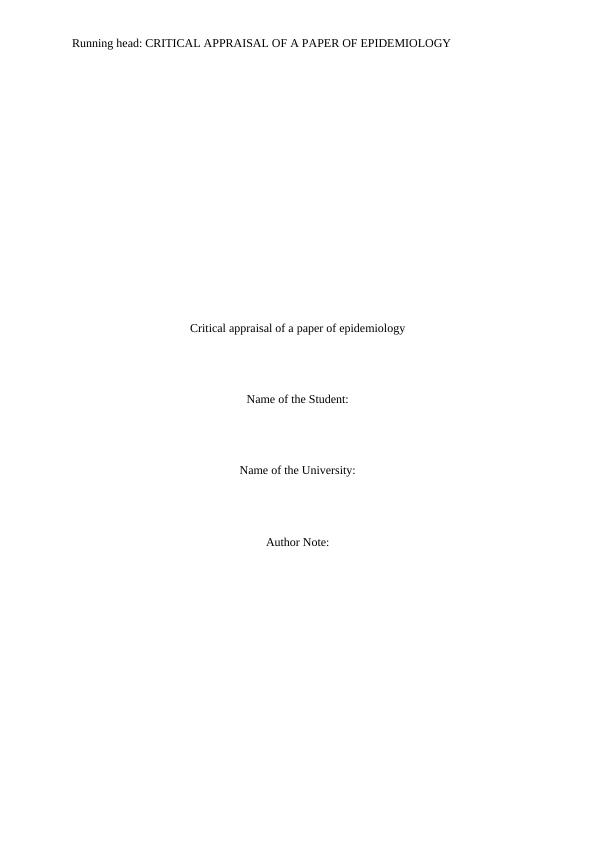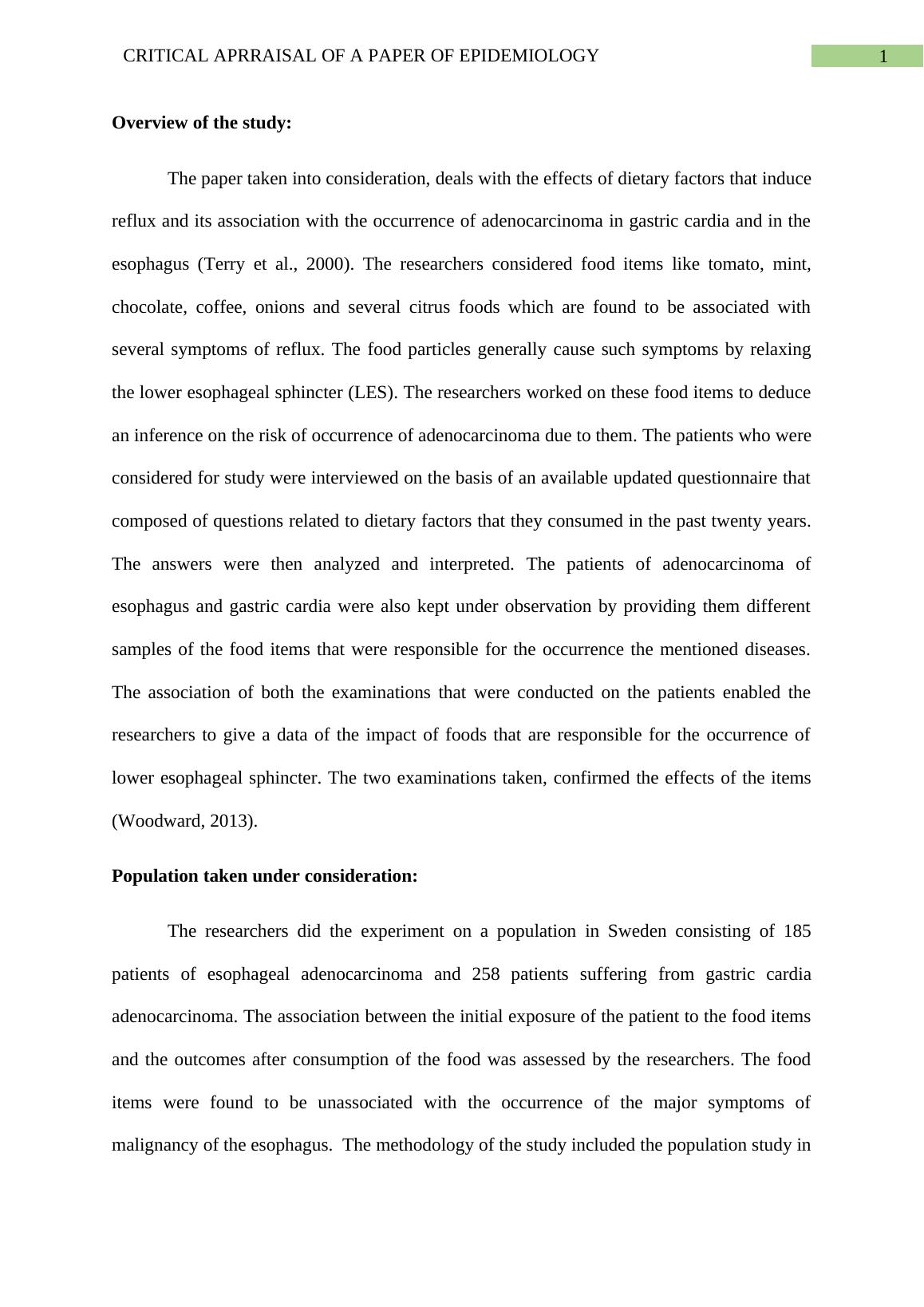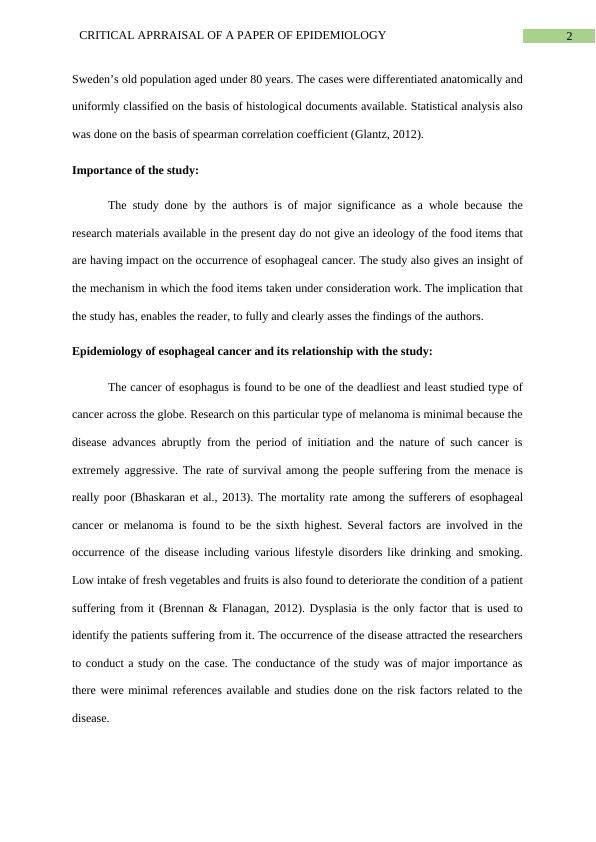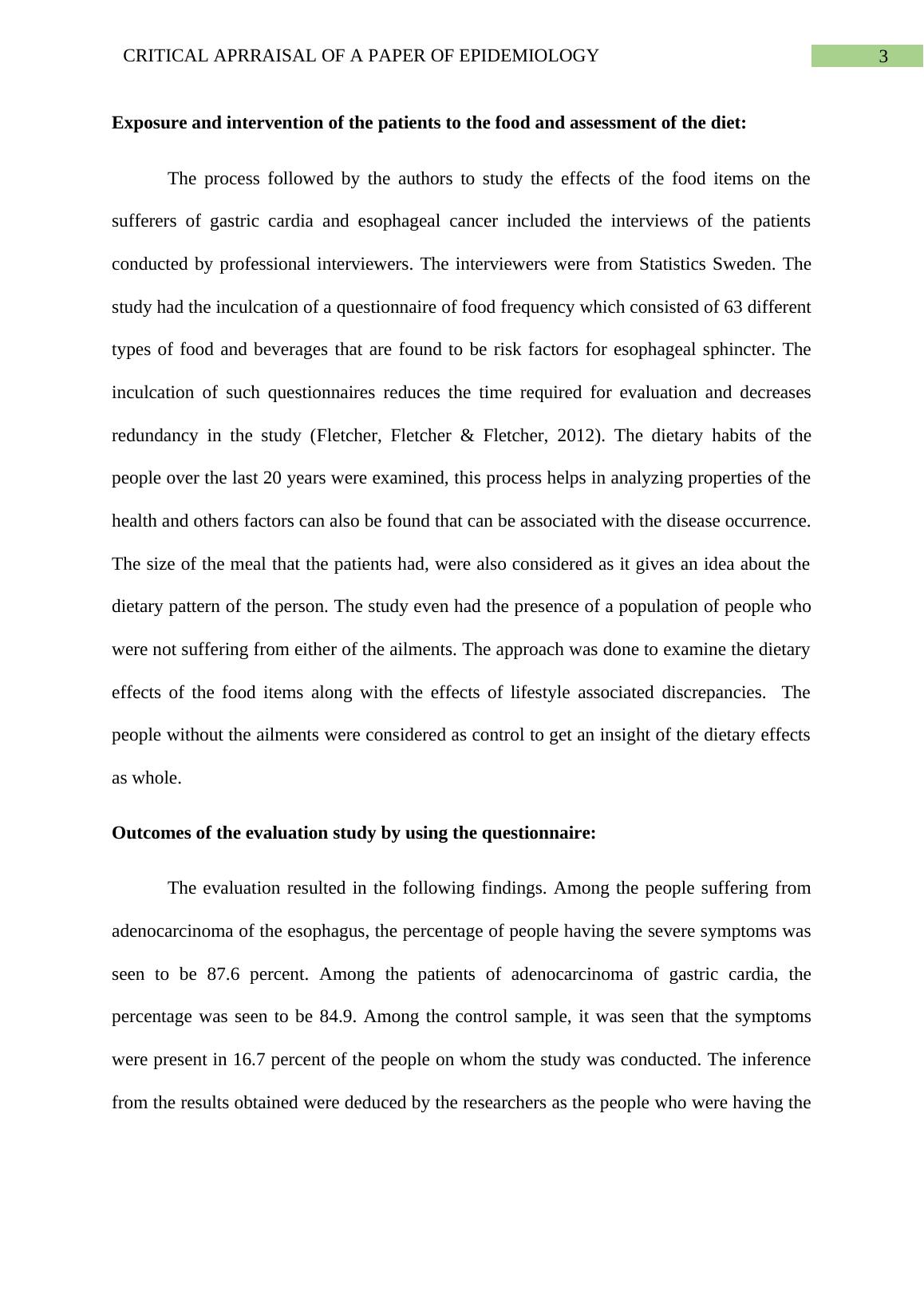Paper on Epidemiology - Effects of Dietary Factors
Added on 2020-03-16
13 Pages3561 Words44 Views
Running head: CRITICAL APPRAISAL OF A PAPER OF EPIDEMIOLOGY
Critical appraisal of a paper of epidemiology
Name of the Student:
Name of the University:
Author Note:
Critical appraisal of a paper of epidemiology
Name of the Student:
Name of the University:
Author Note:

1CRITICAL APRRAISAL OF A PAPER OF EPIDEMIOLOGY
Overview of the study:
The paper taken into consideration, deals with the effects of dietary factors that induce
reflux and its association with the occurrence of adenocarcinoma in gastric cardia and in the
esophagus (Terry et al., 2000). The researchers considered food items like tomato, mint,
chocolate, coffee, onions and several citrus foods which are found to be associated with
several symptoms of reflux. The food particles generally cause such symptoms by relaxing
the lower esophageal sphincter (LES). The researchers worked on these food items to deduce
an inference on the risk of occurrence of adenocarcinoma due to them. The patients who were
considered for study were interviewed on the basis of an available updated questionnaire that
composed of questions related to dietary factors that they consumed in the past twenty years.
The answers were then analyzed and interpreted. The patients of adenocarcinoma of
esophagus and gastric cardia were also kept under observation by providing them different
samples of the food items that were responsible for the occurrence the mentioned diseases.
The association of both the examinations that were conducted on the patients enabled the
researchers to give a data of the impact of foods that are responsible for the occurrence of
lower esophageal sphincter. The two examinations taken, confirmed the effects of the items
(Woodward, 2013).
Population taken under consideration:
The researchers did the experiment on a population in Sweden consisting of 185
patients of esophageal adenocarcinoma and 258 patients suffering from gastric cardia
adenocarcinoma. The association between the initial exposure of the patient to the food items
and the outcomes after consumption of the food was assessed by the researchers. The food
items were found to be unassociated with the occurrence of the major symptoms of
malignancy of the esophagus. The methodology of the study included the population study in
Overview of the study:
The paper taken into consideration, deals with the effects of dietary factors that induce
reflux and its association with the occurrence of adenocarcinoma in gastric cardia and in the
esophagus (Terry et al., 2000). The researchers considered food items like tomato, mint,
chocolate, coffee, onions and several citrus foods which are found to be associated with
several symptoms of reflux. The food particles generally cause such symptoms by relaxing
the lower esophageal sphincter (LES). The researchers worked on these food items to deduce
an inference on the risk of occurrence of adenocarcinoma due to them. The patients who were
considered for study were interviewed on the basis of an available updated questionnaire that
composed of questions related to dietary factors that they consumed in the past twenty years.
The answers were then analyzed and interpreted. The patients of adenocarcinoma of
esophagus and gastric cardia were also kept under observation by providing them different
samples of the food items that were responsible for the occurrence the mentioned diseases.
The association of both the examinations that were conducted on the patients enabled the
researchers to give a data of the impact of foods that are responsible for the occurrence of
lower esophageal sphincter. The two examinations taken, confirmed the effects of the items
(Woodward, 2013).
Population taken under consideration:
The researchers did the experiment on a population in Sweden consisting of 185
patients of esophageal adenocarcinoma and 258 patients suffering from gastric cardia
adenocarcinoma. The association between the initial exposure of the patient to the food items
and the outcomes after consumption of the food was assessed by the researchers. The food
items were found to be unassociated with the occurrence of the major symptoms of
malignancy of the esophagus. The methodology of the study included the population study in

2CRITICAL APRRAISAL OF A PAPER OF EPIDEMIOLOGY
Sweden’s old population aged under 80 years. The cases were differentiated anatomically and
uniformly classified on the basis of histological documents available. Statistical analysis also
was done on the basis of spearman correlation coefficient (Glantz, 2012).
Importance of the study:
The study done by the authors is of major significance as a whole because the
research materials available in the present day do not give an ideology of the food items that
are having impact on the occurrence of esophageal cancer. The study also gives an insight of
the mechanism in which the food items taken under consideration work. The implication that
the study has, enables the reader, to fully and clearly asses the findings of the authors.
Epidemiology of esophageal cancer and its relationship with the study:
The cancer of esophagus is found to be one of the deadliest and least studied type of
cancer across the globe. Research on this particular type of melanoma is minimal because the
disease advances abruptly from the period of initiation and the nature of such cancer is
extremely aggressive. The rate of survival among the people suffering from the menace is
really poor (Bhaskaran et al., 2013). The mortality rate among the sufferers of esophageal
cancer or melanoma is found to be the sixth highest. Several factors are involved in the
occurrence of the disease including various lifestyle disorders like drinking and smoking.
Low intake of fresh vegetables and fruits is also found to deteriorate the condition of a patient
suffering from it (Brennan & Flanagan, 2012). Dysplasia is the only factor that is used to
identify the patients suffering from it. The occurrence of the disease attracted the researchers
to conduct a study on the case. The conductance of the study was of major importance as
there were minimal references available and studies done on the risk factors related to the
disease.
Sweden’s old population aged under 80 years. The cases were differentiated anatomically and
uniformly classified on the basis of histological documents available. Statistical analysis also
was done on the basis of spearman correlation coefficient (Glantz, 2012).
Importance of the study:
The study done by the authors is of major significance as a whole because the
research materials available in the present day do not give an ideology of the food items that
are having impact on the occurrence of esophageal cancer. The study also gives an insight of
the mechanism in which the food items taken under consideration work. The implication that
the study has, enables the reader, to fully and clearly asses the findings of the authors.
Epidemiology of esophageal cancer and its relationship with the study:
The cancer of esophagus is found to be one of the deadliest and least studied type of
cancer across the globe. Research on this particular type of melanoma is minimal because the
disease advances abruptly from the period of initiation and the nature of such cancer is
extremely aggressive. The rate of survival among the people suffering from the menace is
really poor (Bhaskaran et al., 2013). The mortality rate among the sufferers of esophageal
cancer or melanoma is found to be the sixth highest. Several factors are involved in the
occurrence of the disease including various lifestyle disorders like drinking and smoking.
Low intake of fresh vegetables and fruits is also found to deteriorate the condition of a patient
suffering from it (Brennan & Flanagan, 2012). Dysplasia is the only factor that is used to
identify the patients suffering from it. The occurrence of the disease attracted the researchers
to conduct a study on the case. The conductance of the study was of major importance as
there were minimal references available and studies done on the risk factors related to the
disease.

3CRITICAL APRRAISAL OF A PAPER OF EPIDEMIOLOGY
Exposure and intervention of the patients to the food and assessment of the diet:
The process followed by the authors to study the effects of the food items on the
sufferers of gastric cardia and esophageal cancer included the interviews of the patients
conducted by professional interviewers. The interviewers were from Statistics Sweden. The
study had the inculcation of a questionnaire of food frequency which consisted of 63 different
types of food and beverages that are found to be risk factors for esophageal sphincter. The
inculcation of such questionnaires reduces the time required for evaluation and decreases
redundancy in the study (Fletcher, Fletcher & Fletcher, 2012). The dietary habits of the
people over the last 20 years were examined, this process helps in analyzing properties of the
health and others factors can also be found that can be associated with the disease occurrence.
The size of the meal that the patients had, were also considered as it gives an idea about the
dietary pattern of the person. The study even had the presence of a population of people who
were not suffering from either of the ailments. The approach was done to examine the dietary
effects of the food items along with the effects of lifestyle associated discrepancies. The
people without the ailments were considered as control to get an insight of the dietary effects
as whole.
Outcomes of the evaluation study by using the questionnaire:
The evaluation resulted in the following findings. Among the people suffering from
adenocarcinoma of the esophagus, the percentage of people having the severe symptoms was
seen to be 87.6 percent. Among the patients of adenocarcinoma of gastric cardia, the
percentage was seen to be 84.9. Among the control sample, it was seen that the symptoms
were present in 16.7 percent of the people on whom the study was conducted. The inference
from the results obtained were deduced by the researchers as the people who were having the
Exposure and intervention of the patients to the food and assessment of the diet:
The process followed by the authors to study the effects of the food items on the
sufferers of gastric cardia and esophageal cancer included the interviews of the patients
conducted by professional interviewers. The interviewers were from Statistics Sweden. The
study had the inculcation of a questionnaire of food frequency which consisted of 63 different
types of food and beverages that are found to be risk factors for esophageal sphincter. The
inculcation of such questionnaires reduces the time required for evaluation and decreases
redundancy in the study (Fletcher, Fletcher & Fletcher, 2012). The dietary habits of the
people over the last 20 years were examined, this process helps in analyzing properties of the
health and others factors can also be found that can be associated with the disease occurrence.
The size of the meal that the patients had, were also considered as it gives an idea about the
dietary pattern of the person. The study even had the presence of a population of people who
were not suffering from either of the ailments. The approach was done to examine the dietary
effects of the food items along with the effects of lifestyle associated discrepancies. The
people without the ailments were considered as control to get an insight of the dietary effects
as whole.
Outcomes of the evaluation study by using the questionnaire:
The evaluation resulted in the following findings. Among the people suffering from
adenocarcinoma of the esophagus, the percentage of people having the severe symptoms was
seen to be 87.6 percent. Among the patients of adenocarcinoma of gastric cardia, the
percentage was seen to be 84.9. Among the control sample, it was seen that the symptoms
were present in 16.7 percent of the people on whom the study was conducted. The inference
from the results obtained were deduced by the researchers as the people who were having the

End of preview
Want to access all the pages? Upload your documents or become a member.
Related Documents
Concept of Epidemiology : Assignmentlg...
|12
|3321
|204
Introduction to Epidemiology (401076)lg...
|10
|3279
|124
Paper on Epidemiology in Adenocarcinomalg...
|11
|3111
|44
Association between Carbohydrate Nutrition and Successful Aginglg...
|6
|1321
|47
Alzheimer - Dementia in UKlg...
|16
|2476
|24
